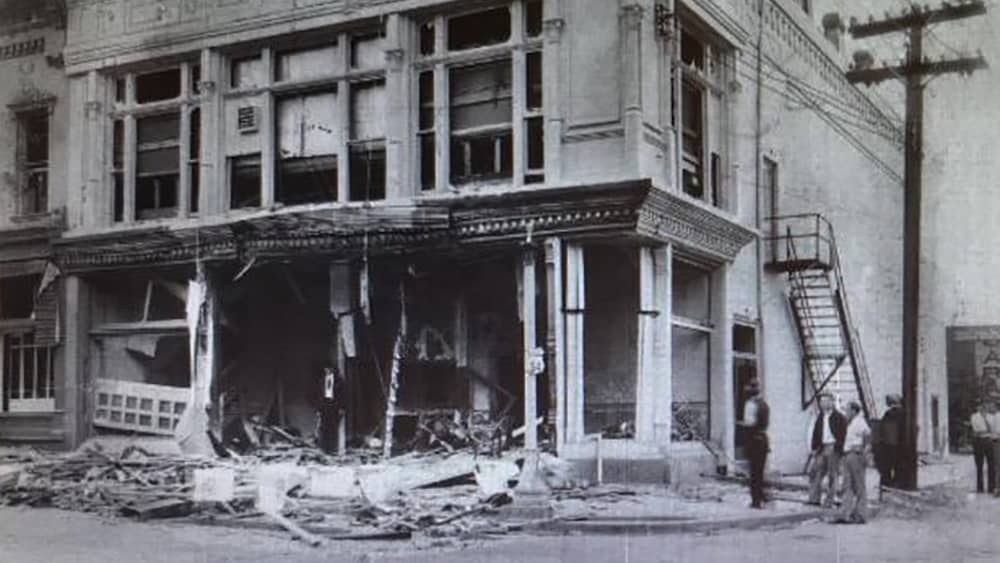
LOUISIANA, Mo. — Before it burned, Louisiana’s Clark Theatre was bombed.
All initially was quiet when night watchman Pleasant Carl Edwards did a routine check at 1:45 a.m. on Thursday, May 28, 1931. The movie palace had opened just six days earlier as a competitor to the nearby Lou-Mo Theatre.
After doing his rounds, Edwards came back down the street and spotted a car with two men parked near the Clark. They ducked down when Edwards shined a flashlight on them, but the officer did not stop to ask questions.
At 2:20 a.m., Edwards and all of Louisiana were jolted by a detonation louder than the sound of any war film.
‘Scene of wreckage’
Hundreds of people came downtown and “viewed a scene of wreckage never before seen in the history of Louisiana,” the Press-Journal newspaper said.
Dynamite placed at the Clark’s front door tore a three-foot hole in the sidewalk. An iron pillar was the only thing holding up the second floor after concrete a foot thick was blown away.
Plaster, glass and splinters were everywhere, and at least 35 businesses and apartments within a block along Georgia Street had damage. The two mysterious men had disappeared.
Theater owner Clark Armentrout said it was “the work of gangsters but he did not know by whom they were hired,” the Press-Journal said.
The picture scheduled for that night was “The Front Page,” which depicted a newspaper reporter’s quest to interview a criminal. Louisiana residents “deplore the occurrence beyond power of expression” and “the motive of the perpetrators…could find no justification in their minds,” according to the paper.
Insurance paid for the damage, which was estimated at $10,000 — almost $164,000 now — with another $5,000 of devastation to nearby structures. The City Council offered a $500 reward for a conviction and ordered that an extra policeman be assigned to patrol the downtown until repairs were made.
The Great Depression had put a halt to many building projects, but renovations to the Clark began on June 2 and the work was prompt. Just about every seat was filled for the June 6 re-opening, with the Winnie Lightner and Joe E. Brown comedy “Sit Tight” and the documentary “Adventures in Africa.”
“The sound was good and there was not the slightest hitch in presenting the programs, which is evidence that the equipment was not damaged by the explosion and is in perfect working order,” the Press-Journal told readers.
‘Chicago grenade’
Hollywood had essentially glamorized gangsters in the years leading up to the Depression.
One example was 1928’s “Dressed to Kill,” which included Illinois actress Mary Astor, who was born in Quincy as Lucile Langhanke in 1906.
A film that critics would later consider one of the best from the genre – “The Public Enemy” starring James Cagney and Jean Harlow – had been released just one week before the Clark opened on May 22, 1931.
So, it was no surprise that talk of a mob connection was bandied as a reason for the Clark Theatre bombing, especially after Armentrout spoke about it. The theory went that Lou-Mo owner C.E. Maberry used his Chicago contacts in an effort to put the Clark out of business.
There was no evidence linking Maberry to any gangster and it appears police never questioned him about the bombing. However, somebody certainly had it in for Armentrout.
The night after the Clark bombing, a similar scare happened at the KP Opera House in Pittsfield. The feature just happened to be “The Front Page.” A boy walking through an alley beside the theater discovered a black bundle with a fuse.
“After testing the dangerous-looking missile as worried theatre patrons looked on from a distance, officials declared it was only a pineapple dipped in oil,” the Press-Journal said. “No one was inclined to view the scare as a joke, however.”
Gang involvement again was discussed because mobsters sometimes disguised a bomb in such a manner and gave it the nickname “Chicago grenade.”
Armentrout and Police Chief Jefferson Davis joined the Pike County Sheriff’s Department in the investigation, but no identifying evidence was found. Armentrout’s wife, Jennie, prevented panic by stopping the film and calmly telling customers that they had to evacuate.
“The pineapple, its fake fuse ripped out, was then lowered cautiously into a bucket of water by one of the crowd and the fake was exposed,” the Press-Journal reported.
The economic downturn had caused labor troubles nationally, but work on the Lou-Mo and Clark had provided much-needed jobs in Louisiana. Even if the motive was to run the Clark out of business, it didn’t work. By the middle of 1932, the Lou-Mo had closed. Louisiana just couldn’t support two large theaters, especially when they were a block apart.
The Clark would be around for five more decades, but flames would dash any hopes of a revival after lights of the last motion picture faded.